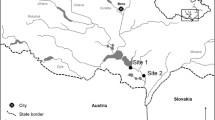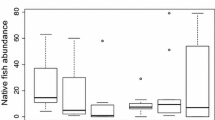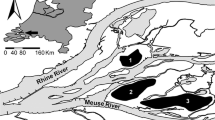Abstract
Habitat changes induced by restoration can favour invasive species, thereby thwarting the main biological objectives of restoration and possibly limiting a project’s success. Here, we focus on a study site located along the Old Rhine River that was being restored in 2013 by controlled bank erosion and implementation of artificial transverse groynes. In the Upper Rhine (Franco-German border), the first reports of the bighead goby (Ponticola kessleri, Günther 1861) and round goby (Neogobius melanostomus, Pallas 1814) were 2010 and 2011, respectively. As the round goby largely dominates the overall goby assemblage, we asked about the consequences of its presence on the restored site. Electrofishing was carried out from 2013 to 2021 in parallel to a benthic macroinvertebrate monitoring conducted from 2014 to 2019. In 2015/2016, we looked at goby’s predation by studying their stomach contents through macroscopic visualisation and eDNA metabarcoding analysis. For results, gobies were found in large densities dominated by N. melanostomus, increasing over time to the detriment of local fish species. No predation was observed on native fish species but N. melanostomus cannibalism reached 9%. Round goby’s predation was opportunistic, based on the most abundant benthic macroinvertebrates: (i) low trophic level taxa, and (ii) invasive amphipod crustaceans. If round gobies fed on some insects, they did not prevent the colonization of new taxa on the habitats that appeared after restoration. We stress that the high abundance of N. melanostomus has led to profound changes in the food web structure and species interactions in the Old Rhine River, but it is unlikely that it masked the restoration consequences on macroinvertebrates 6 years after the restoration. These results support (i) the importance in carrying out long-term monitoring to confirm that a stronger trophic impact is not ultimately delayed, and (ii) the diversification of habitats as an option for limiting the invasion by gobies.





Similar content being viewed by others
Data availability
The datasets generated and analysed during the current study are available from the corresponding author on reasonable request.
References
Barnes MA, Turner CR, Jerde CL, Renshaw MA, Chadderton WL, Lodge DM (2014) Environmental conditions influence eDNA persistence in aquatic systems. Environ Sci Technol 48(3):1819–1827. https://doi.org/10.1021/es404734p
Beisel JN, Lévêque C (2010) Introductions d'espèces dans les milieux aquatiques. Faut-il avoir peur des invasions biologiques? Versailles, France, Quae, 248 p.
Belliard J, Ditches J, Roset N, Dembski S (2012) Guide pratique de mise en œuvre des opérations de pêche a l’électricité dans le cadre des réseaux de suivi des peuplements de poissons. ONEMA.
Bernauer D, Jansen W (2006) Recent invasions of alien macroinvertebrates and loss of native species in the upper Rhine River. Germany Aquat Invasions 1(2):55–71. https://doi.org/10.3391/ai.2006.1.2.2
Borcherding J, Staas S, Krüger S, Ondračková M, Šlapanský L, Jurajda P (2011) Non-native Gobiid species in the lower River Rhine (Germany): recent range extensions and densities. J Appl Ichthyol 27(1):153–155. https://doi.org/10.1111/j.1439-0426.2010.01662.x
Borza P, Erős T, Oertel N (2009) Food resource partitioning between two invasive gobiid species (Pisces, Gobiidae) in the littoral zone of the River Danube. Hungary Int Rev Hydrobiol 94(5):609–621. https://doi.org/10.1002/iroh.200911134
Brandner J, Auerswald K, Cerwenka AF, Schliewen UK, Geist J (2013) Comparative feeding ecology of invasive Ponto-Caspian gobies. Hydrobiol 703(1):113–131. https://doi.org/10.1007/s10750-012-1349-9
Burkett EM, Jude DJ (2015) Long-term impacts of invasive round goby Neogobius melanostomus on fish community diversity and diets in the St. Clair River, Michigan. J Gt Lakes Res. 41(3):862–872
Chardon V, Schmitt L, Piégay H, Beisel JN, Staentzel C, Barillier A, Clutier A (2020) Effects of transverse Groynes on Meso-Habitat suitability for native fish species on a regulated by-passed large river: a case study along the rhine river. Water 12(4):987. https://doi.org/10.3390/w12040987
Charles H, Dukes JS (2008) Impacts of Invasive Species on Ecosystem Services. In: Invasions B, Studies E, (Analysis and Synthesis, (eds) Nentwig W. Springer, Berlin, Heidelberg, pp 217–237
CIPR. Commission internationale pour la Protection du Rhin. (2015). Suivi de la faune piscicole du Rhin – Programme d’analyse biologique Rhin 2012/2013 de la CIPR, élément de qualité “Faune piscicole”. Report 228.
Clutier A, Aelbrecht D, El Kadi Abderrezzak K, Die Moran A, Pinte K, Barillier A (2012) Restauration du transport sédimentaire dans le Vieux Rhin par érosion maîtrisée des berges. International Conference on Integrative Sciences and Sustainable Development of Rivers 2012, Lyon, France.
Corkum LD, Sapota MR, Skora KE (2004) The round goby, Neogobius melanostomus, a fish invader on both sides of the Atlantic Ocean. Biol Invasions 6(2):173–181. https://doi.org/10.1023/B:BINV.0000022136.43502.db
David P, Thebault E, Anneville O, Duyck PF, Chapuis E, Loeuille N (2017) Impacts of invasive species on food webs: a review of empirical data. Adv Ecol Res 56:1–60. https://doi.org/10.1016/bs.aecr.2016.10.001
David GM, Staentzel C, Schlumberger O, Perrot-Minnot MJ, Beisel JN, Hardion L (2018) A minimalist macroparasite diversity in the round goby of the Upper Rhine reduced to an exotic acanthocephalan lineage. Parasitology 145(8):1020–1026. https://doi.org/10.1017/S0031182017002177
De Barba M, Miquel C, Boyer F, Mercier C, Rioux D, Coissac E, Taberlet P (2014) DNA metabarcoding multiplexing and validation of data accuracy for diet assessment: application to omnivorous diet. Mol Ecol Resour 14(2):306–323. https://doi.org/10.1111/1755-0998.12188
Diggins TP, Kaur J, Chakraborti RK, DePinto JV (2002) Diet choice by the exotic round goby (Neogobius melanostomus) as influenced by prey motility and environmental complexity. J Gt Lakes Res 28(3):411–420. https://doi.org/10.1016/S0380-1330(02)70594-7
ECOTEC (2015) Rapport d’étude. Aménagement hydroélectrique de Kembs. Suivi piscicole 2015 pour la station O3. December 2015. 20 p.
Ficetola GF, Bonin A, Boyer F, Valentini A, Meyer A, Dejean T, Gaboriaud C, Usseglio-Polatera P, Taberlet P (2020) Metabarcodes for the monitoring of freshwater benthic biodiversity through eDNA. Authorea Preprints. https://doi.org/10.22541/au.158592495.58769102
French Committee IUCN, MNHN, SFI & AFB, (2019) The Red List of threatened species in France - Chapter. Freshwater fishes of metropolitan France, Paris, France
Friberg N (2014) Impacts and Indicators of Change in Lotic Ecosystems. Wires Water. https://doi.org/10.1002/wat2.1040
Gallardo B, Clavero M, Sánchez MI, Vilà M (2015) Global ecological impacts of invasive species in aquatic ecosystems. Global Change Biol 22(1):151–163. https://doi.org/10.1111/gcb.13004
Garnier A, Barillier A (2015) The Kembs project: environmental integration of a large existing hydropower scheme. Houille Blanche 4:21–28. https://doi.org/10.1051/lhb/20150041
Guardiola M, Uriz MJ, Taberlet P, Coissac E, Wangensteen OS, Turon X (2015) Deep-sea deep-sequencing: metabarcoding extracellular DNA from sediments of marine canyons. PLoS ONE 10(10):e0139633. https://doi.org/10.1371/journal.pone.0139633
Havel JE, Kovalenko KE, Thomaz SM, Amalfitano S, Kats LB (2015) Aquatic invasive species: challenges for the future. Hydrobiologia 750(1):147–170. https://doi.org/10.1007/s10750-014-2166-0
Hirsch PE, N’Guyen A, Adrian-Kalchhauser I, Burkhardt-Holm P (2016) What do we really know about the impacts of one of the 100 worst invaders in Europe? A Reality Check Ambio 45(3):267–279
Hunter JR, Kimbrell CA (1980) Early life history of Pacific mackerel. Scomber Japonicus Fish Bull US 78(1):89–101
Hyslop EJ (1980) Stomach contents analysis—a review of methods and their application. J Fish Biol 17(4):411–429. https://doi.org/10.1111/j.1095-8649.1980.tb02775.x
Jude DJ, DeBoe SF (1996) Possible impact of gobies and other introduced species on habitat restoration efforts. Can J Fish Aquat Sci 53(S1):136–141. https://doi.org/10.1139/f96-001
Kinnison MT, Hairston NG (2007) Eco-evolutionary conservation biology: contemporary evolution and the dynamics of persistence. Funct Ecol 21(3):444–454
Lapin K, Bernhardt KG, Mayer E, Roithmayr S, Neureiter J, Horvath C (2016) Monitoring river restoration efforts: do invasive alien plants endanger the success? A case study of the Traisen River. J Environ Prot 7(6):831–843
Lederer AM, Janssen J, Reed T, Wolf A (2008) Impacts of the introduced round goby (Apollonia melanostoma) on dreissenids (Dreissena polymorpha and Dreissena bugensis) and on macroinvertebrate community between 2003 and 2006 in the littoral zone of Green Bay. Lake Michigan J Gt Lakes Res 34(4):690–697. https://doi.org/10.1016/S0380-1330(08)71611-3
Leuven RSEW, van der Velde G, Baijens I, Snijders J, van der Zwart C, Lenders HR, bij de Vaate A, (2009) The river Rhine: a global highway for dispersal of aquatic invasive species. Biol Invasions 11(9):1989–2008. https://doi.org/10.1007/s10530-009-9491-7
Lodge DM, Turner CR, Jerde CL, Barnes MA, Chadderton L, Egan SP, Feder JL, Mahon AR, Pfrender ME (2012) Conservation in a cup of water: estimating biodiversity and population abundance from environmental DNA. Mol Ecol 21(11):2555–2558. https://doi.org/10.1111/j.1365-294X.2012.05600.x
Manné S, Poulet N (2008) First record of the western tubenose goby Proterorhinus semilunaris (Heckel, 1837) in France. Knowl Manag Aquat Ec. https://doi.org/10.1051/kmae:2008009
Manné S, Poulet N, Dembski S (2013) Colonisation of the Rhine basin by non-native gobiids: an update of the situation in France. Knowl Manag Aquat Ec. https://doi.org/10.1051/kmae/2013069
Masson L, Masson G, Beisel JN, Gutowsky LFG, Fox MG (2018) Consistent life history shifts along invasion routes? An examination of round goby populations invading on two continents. Divers Distrib 24(6):841–852. https://doi.org/10.1111/ddi.12726
Nagelkerke LA, van Onselen E, van Kessel N, Leuven RS (2018) Functional feeding traits as predictors of invasive success of alien freshwater fish species using a food-fish model. PLoS ONE 13(6):e0197636
Nevers MB, Byappanahalli MN, Morris CC, Shively D, Przybyla-Kelly K, Spoljaric AM, Dickey J, Roseman EF (2018) Environmental DNA (eDNA): a tool for quantifying the abundant but elusive round goby (Neogobius melanostomus). PLoS ONE 13(1):0191720. https://doi.org/10.1371/journal.pone
Nielsen JM, Clare EL, Hayden B, Brett MT, Kratina P (2017) Diet tracing in ecology: method comparison and selection. Methods Ecol Evol 9:278–291. https://doi.org/10.1111/2041-210X.12869
Panov VE, Alexandrov B, Arbačiauskas K, Binimelis R, Copp GH, Grabowski M, Lucy F, Leuven RSEW, Nehring S, Paunović M, Semenchenko V, Son O, M, (2009) Assessing the risks of aquatic species invasions via European inland waterways: from concepts to environmental indicators. Integr Environ Assess 5(1):110–126. https://doi.org/10.1897/ieam_2008-034.1
Persat H, Copp GH (1989) Electrofishing and Point Abundance Sampling for the ichthyology of large rivers. In Cowx I (Ed.), Developments in Electrofishing Proceedings of an International Symposium, Hull 1988, Fishing News (Books), Blackwell Scientific Publishing, Oxford, UK., 203–215.
R Core Team (2017) R: A language and environment for statistical computing. R Foundation for Statistical Computing, Vienna, Austria. R-project. org/
Ramler D, Keckeis H (2020) Effects of hydraulic engineering restoration measures on invasive gobies in a large river (Danube, Austria). Biol Invasions 22(2):437–453
Ray WJ, Corkum LD (2001) Habitat and site affinity of the round goby. J Great Lakes Res 27(3):329–334. https://doi.org/10.1016/S0380-1330(01)70648-X
Reier S, Sattmann H, Schwaha T, Harl J, Konecny R, Haring E (2019) An integrative taxonomic approach to reveal the status of the genus Pomphorhynchus Monticelli, 1905 (Acanthocephala: Pomphorhynchidae) in Austria. Int J Parasitol: Parasites and Wildlife 8:145–155
Sabater S, Elosegi A, Ludwig R (Eds.) (2018) Multiple stressors in river ecosystems: status, impacts and prospects for the future. Elsevier
Sala OE, Chapin FS, Armesto JJ, Berlow E, Bloomfield J, Dirzo R et al (2000) Global biodiversity scenarios for the year 2100. Science 287(5459):1770–1774. https://doi.org/10.1126/science.287.5459.1770
Simberloff D, Martin JL, Genovesi P, Maris V, Wardle DA, Aronson J, Courchamp F, Galil B, García-Berthou E, Pascal M, Pyšek P, Sousa R, Tabacchi E, Vilà M (2013) Impacts of biological invasions: what’s what and the way forward. Trends Ecol Evol 28(1):58–66. https://doi.org/10.1016/j.tree.2012.07.013
Staentzel C, Combroux I, Barillier A, Schmitt L, Chardon V, Garnier A, Beisel JN (2018a) Réponses des communautés biologiques à des actions de restauration de grands fleuves (Vieux Rhin, France). Houille Blanche 2:99–106. https://doi.org/10.1051/lhb/2018024
Staentzel C, Beisel JN, Gallet S, Hardion L, Barillier A, Combroux I (2018b) A multiscale assessment protocol to quantify effects of restoration works on alluvial vegetation communities. Ecol Indic 90:643–652. https://doi.org/10.1016/j.ecolind.2018.03.050
Staentzel C, Combroux I, Barillier A, Grac C, Chanez E, Beisel JN (2019) Effects of a river restoration project along the old rhine river (France-Germany): response of macroinvertebrate communities. Ecol Eng 127:114–124. https://doi.org/10.1016/j.ecoleng.2018.10.024
Steinhart GB, Marschall EA, Stein RA (2004) Round goby predation on smallmouth bass offspring in nests during simulated catch-and-release angling. T Am Fish Soc 133(1):121–131. https://doi.org/10.1577/T03-020
Števove B, Kováč V (2013) Do invasive bighead goby N.eogobius kessleri and round goby N melanostomus (Teleostei, Gobiidae) compete for food? Knowl Manag Aquat Ec 410:08. https://doi.org/10.1051/kmae/2013064
Strayer DL (2010) Alien species in fresh waters: ecological effects, interactions with other stressors, and prospects for the future. Freshw Biol 55:152–174
Taberlet P, Coissac E, Pompanon F, Brochmann C, Willerslev E (2012) Toward next-generation biodiversity assessment using DNA metabarcoding. Mol Ecol 21(8):2045–2050
Taberlet P, Bonin A, Zinger L, Coissac E (2018) Environmental DNA: for biodiversity research and monitoring. Oxford University Press, Oxford
Tachet H, Richoux P, Bournaud M, Usseglio-Polatera P (2010) Invertébrés d’eau douce: systématique, biologie, écologie, vol 15. CNRS éditions, Paris
Townsend CR (1989) The patch dynamics concept of stream community ecology. J N Am Benthol Soc 8(1):36–50
Valentini A, Miquel C, Nawaz M, Bellemain E, Coissac E, Pompanon F, Gielly L, Cruaud C, Nascetti G, Wincker P, Swenson JE, Taberlet P (2009) New perspectives in diet analysis based on DNA barcoding and parallel pyrosequencing: the trnL approach. Mol Ecol Resour 9(1):51–60. https://doi.org/10.1111/j.1755-0998.2008.02352.x
Valentini A, Taberlet P, Miaud C, Civade R, Herder J et al (2016) Next-generation monitoring of aquatic biodiversity using environmental DNA metabarcoding. Mol Ecol 25(4):929–942
Wantzen KM, Uehlinger U, Van der Velde G, Leuven RSEW, Schmitt L, Beisel JN, Chapter 6 - The Rhine River basin, Editor(s): Tockner K, Zarfl C, Robinson CT, Rivers of Europe (Second Edition), Elsevier, 2022, Pages 331–389, ISBN 9780081026120,
Young JA, Marentette JR, Gross C, McDonald JI, Verma A, Marsh-Rollo SE, MacDonald PDM, Earn DJD, Balshine S (2010) Demography and substrate affinity of the round goby (Neogobius melanostomus) in Hamilton Harbour. J Great Lakes Res 36(1):115–122. https://doi.org/10.1016/j.jglr.2009.11.001
Acknowledgements
We would like to thank the staff at SPYGEN for their technical support in the laboratory. We would like to warmly thank Yann Eckenschwiller, Sophie Louis, Victorien Tallet, Coralie Tarrene, and Camille Berolo from the local 68 Fishing Federation for their help with data acquisition via electrofishing. We also thank Etienne Chanez, Marie-Pierre Ottermatte, Carole Lutz, Gwendoline David and Bernadette François for her helpful contributions to the data acquisition and provision of equipment within the Water Studies Laboratory (LEE) of the National School for Water and Environmental Engineering of Strasbourg (ENGEES). Finally, we are grateful to Murray Hay (Maxafeau Editing Services) for verifying the English of the version of the text. Finally, we thank the reviewers who contributed greatly to the restructuring of the manuscript and its final version.
Funding
This research was funded through a CNRS-EDF partnership agreement, “Management of the Old Rhine River geomorphology" (2014–2017).
Author information
Authors and Affiliations
Corresponding author
Ethics declarations
Conflict of interest
Alice Valentini is a research scientist for a private company that specializes in the use of eDNA for detecting species.
Additional information
Publisher's Note
Springer Nature remains neutral with regard to jurisdictional claims in published maps and institutional affiliations.
Supplementary Information
Below is the link to the electronic supplementary material.
Rights and permissions
Springer Nature or its licensor (e.g. a society or other partner) holds exclusive rights to this article under a publishing agreement with the author(s) or other rightsholder(s); author self-archiving of the accepted manuscript version of this article is solely governed by the terms of such publishing agreement and applicable law.
About this article
Cite this article
Staentzel, C., Schlumberger, O., Barillier, A. et al. Trophic impact of Neogobius melanostomus in a restored site on the Old Rhine River (France). Aquat Sci 85, 46 (2023). https://doi.org/10.1007/s00027-023-00942-2
Received:
Accepted:
Published:
DOI: https://doi.org/10.1007/s00027-023-00942-2




